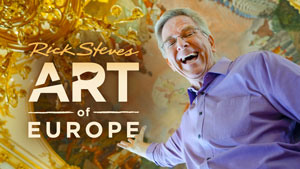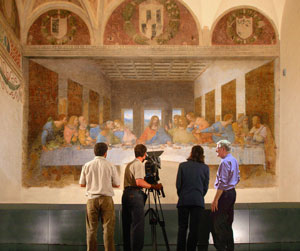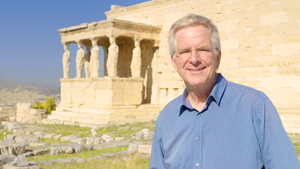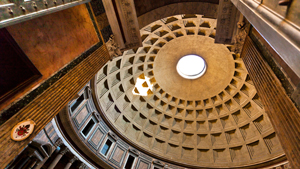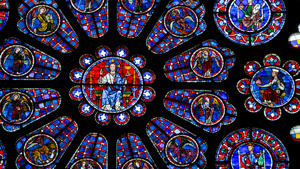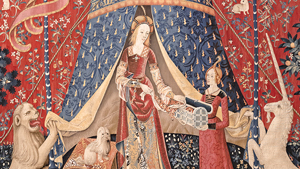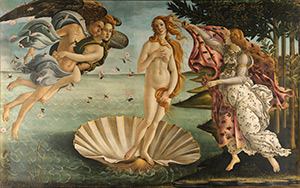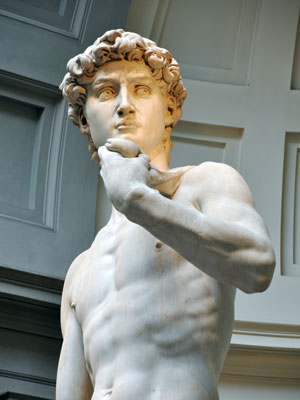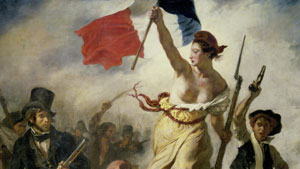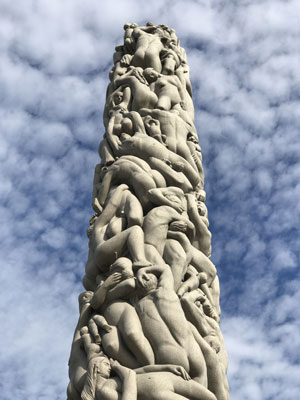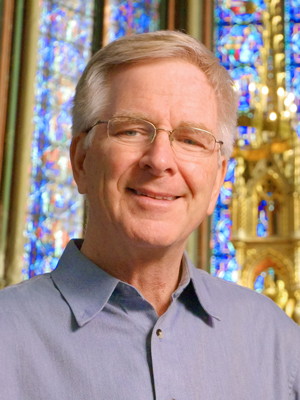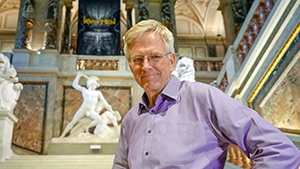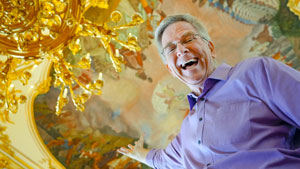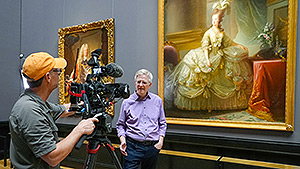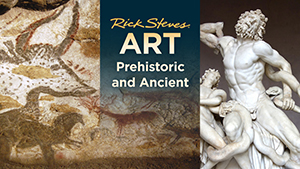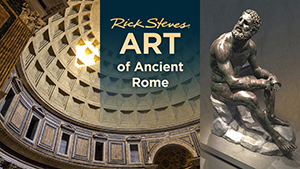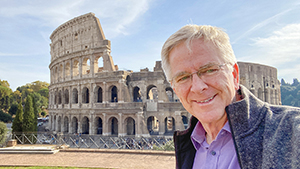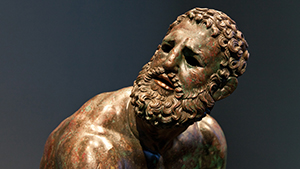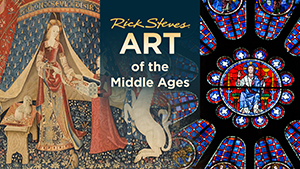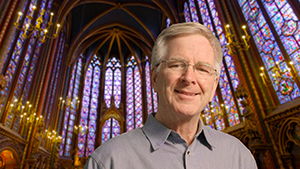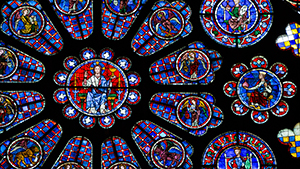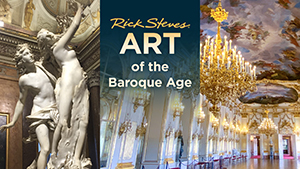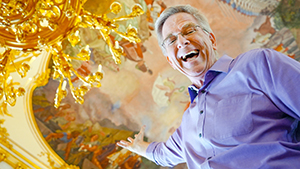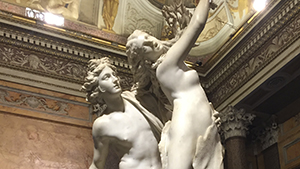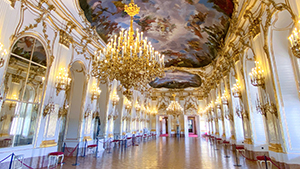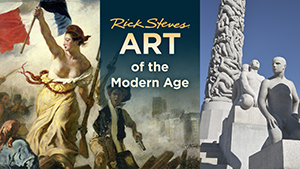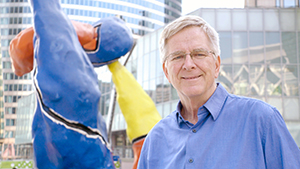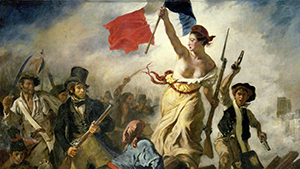Art of Europe Series and Specials
Get a peek into "Rick Steves Art of Europe," an ambitious sweep through the entire span of European art history. Beginning in prehistoric Europe, Egypt, and ancient Greece, Rick weaves a compelling narrative through ancient Rome, medieval Europe, the Renaissance, the Baroque period and the Age of Revolution, and the modern age. Rick brings together the greatest masterpieces he's featured over the decades into a cohesive, entertaining, and inspiring story of Europe's art and architecture. Available as a six-part series and as six separate one-hour specials.
Series length: six hours. Release: October 2022. Specials length: 56 minutes each. Release: April 2023
Promotional Tool Kit
Program Descriptions for the Series
RICK STEVES ART OF EUROPE
(6/60) (TV-PG, Stereo, CC,)
RSOP 000 HD-Base
October 1, 2022
Series Description
Rick Steves Art of Europe (247 words)
Rick Steves Art of Europe is the culmination of three decades of Rick showcasing Europe’s great art and architecture on public television. This ambitious, six-hour sweep through the span of European art history weaves the greatest masterpieces into a fascinating story that’s both entertaining and inspiring. Climbing deep into prehistoric tombs on remote Scottish isles, summiting Michelangelo’s magnificent dome at the Vatican, waltzing through glittering French palaces, and pondering the genius of Picasso and Van Gogh, Rick does for art what he does for travel — makes it fun and accessible.
This six-part journey vividly tells the story: From the earliest European art with its cave paintings and mysterious stone circles, we follow the rise and fall of great civilizations from the massive pyramids of Egypt to the ethereal temples of Greece, to the grandeur of ancient Rome. After a thousand years of Middle Ages — with mighty castles, soaring cathedrals, and radiant religious art — we gaze into the eyes of David and witness how the beauty of ancient times was reborn in the Renaissance. Europe’s divine monarchs — with their awe-inspiring palaces and exuberant art — were eventually countered by the Enlightenment and revolution...bringing a flowering of new styles: from stern Neoclassicism, to unbridled Romanticism, to the sun-dappled canvases of the Impressionists. We’ll finish by careening through Europe’s tumultuous 20th century, exploring ever-wilder frontiers of artistic expression. Through it all, we’ll celebrate the joy of European art as it both connects us to the past and points the way forward.
Rick Steves Art of Europe (63 words)
Rick Steves Art of Europe weaves Europe’s greatest masterpieces into an entertaining and inspiring story. From prehistoric cave paintings to the ancient civilizations of Egypt, Greece, and Rome; through a thousand years of Middle Ages to the Renaissance; and from extravagant Baroque to the tumultuous 20th century, we’ll see how Europe’s art both connects us to the past and points the way forward.
Rick Steves Art of Europe (15 words)
This six-part journey tells the story of Europe’s art from prehistoric to the Modern Age.
Episode Descriptions
Stone Age to Ancient Greece (56 words)
As the Ice Age glaciers melted, European civilization was born — and with it, so was art. From the Stone Age came prehistoric art: mysterious tombs, mighty megaliths, and vivid cave paintings. Then the Egyptians and the Greeks laid the foundations of Western art — creating a world of magical gods, massive pyramids, sun-splashed temples, and ever-more-lifelike statues.
Ancient Rome (58 words)
The Romans gave Europe its first taste of a common culture — and awe-inspiring art. From its groundbreaking architecture to its statues, mosaics, and frescos, Rome engineered bigger and better than anyone before. At its peak, the Roman Empire was a society of unprecedented luxury, with colossal arenas for entertaining the masses and giant monuments to egotistical emperors. And then it fell.
The Middle Ages (61 words)
After Rome fell, Europe spent a thousand years in its Middle Ages. Its art shows how the light of civilization flickered in monasteries and on Europe’s fringes: Christian Byzantium, Moorish Spain, and pagan Vikings. Then, around A.D. 1000, Europe rebounded. The High Middle Ages brought majestic castles, radiant Gothic cathedrals, and exquisite art that dazzled the faithful and the secular alike.
The Renaissance (56 words)
Around 1400, Europe rediscovered the aesthetics of ancient Greece and Rome. This rebirth of classical culture showed itself in the statues, paintings, and architecture of Florence, then spread to Spain, Holland, Germany, and beyond. The Renaissance — from art-loving popes to Leonardo’s Mona Lisa and Michelangelo’s David — celebrated humanism and revolutionized how we think about our world.
Baroque (64 words)
In the 1600s and 1700s, the art of "divine" kings and popes — and of revolutionaries and Reformers — tells the story of a Europe in transition. In the Catholic south, Baroque bubbled over with fanciful decoration and exuberant emotion. In the Protestant north, art was more sober and austere. And in France, the excesses of godlike kings gave way to revolution, Napoleon, and cerebral Neoclassicism.
The Modern Age (55 words)
In the 1800s, the Industrial Revolution spawned new artistic styles: idealized Romanticism, light-chasing Impressionism, sensuous Art Nouveau. Then Europe’s tumultuous 20th century inspired rule-breaking art as exciting as the times: from Expressionism and Cubism to Surrealism to Abstract. The genius of artists like Van Gogh, Picasso, and Dalí express the complexity of our modern world.
Promotional Media for the Series: Videos & Images
We have broadcast-quality promotional videos for the series and episodes.
For hi-res images, right-click on the download link to save the image.
Title screen and Illustrator file.
Download JPG | Download layered file
Download Adobe Illustrator file
Title screen with Rick.
Download JPG | Download layered file
Title screen with Rick at Schönbrunn Palace (Vienna, Austria).
Download JPG | Download layered file
Title screen with Rick at Kunsthistoriches Museum (Vienna, Austria).
Download JPG | Download layered file
Title screen with Rick and crew with Leonardo da Vinci's Last Supper, Church of Santa Maria delle Grazie, Milan, Italy.
Download JPG | Download layered file
Rick and crew with Leonardo da Vinci's Last Supper, Church of Santa Maria delle Grazie, Milan, Italy.
Download image
Poster images.
David poster:
Download JPG | Download layered file
Rick at Kunsthistoriches Museum:
Download JPG | Download layered file
Rick at Schönbrunn Palace:
Download JPG | Download layered file
Skyscraper images.
David skyscraper:
Download JPG | Download layered file
Rick at Kunsthistoriches Museum:
Download JPG | Download layered file
Rick at Schönbrunn Palace:
Download JPG | Download layered file
Cover image.
Download JPG | Download layered file
Rick Steves at the Kunsthistorisches museum in Vienna.
Download image
Rick Steves and the Caryatids of Erechtheion, at the Acropolis in Athens, Greece.
Download image
Cameraman Karel Bauer, Producer Simon Griffith, and Rick Steves in Vienna, Austria.
Download image
Episode 1 — Stone Age to Ancient Greece: Lascaux cave paintings (c. 18,000 bc), replica from Lascaux International Center for Cave Art, Dordogne, France.
Download image
Episode 2 — Ancient Rome: Pantheon (AD 120), Rome, Italy.
Download image
Episode 1 — Stone Age to Ancient Greece: Laocoön (c. 1st century BC), Vatican Museums, Rome, Italy.
Download image
Episode 2 — Ancient Rome: Boxer at Rest (350–50 BC), National Museum of Rome, Italy.
Download image
Episode 3 — Middle Ages: South Rose Window (12th century), Chartres Cathedral, Chartres, France. Download image
Episode 3 — Middle Ages: The Lady and the Unicorn: To My Sole Desire (c. 1500), Anonymous, Cluny Museum, Paris, France.
Download image
Rick Steves at the Piazzale Michelangelo in Florence, Italy. Download image
Rick Steves and Botticelli's Primavera, Uffizi Gallery, Florence, Italy.
Download image
Episode 4 — The Renaissance: The Birth of Venus (c. 1484-1486), Sandro Botticelli, Uffizi Gallery, Florence, Italy.
Download image
Episode 5 — Baroque: Schönbrunn Palace Ballroom, Vienna, Austria.
Download image
Episode 4 — The Renaissance: David (1504), Michelangelo, Accademia Gallery, Florence, Italy.
Download image
Episode 5 — Baroque: Apollo and Daphne (1625), Bernini, Borghese Gallery, Rome, Italy.
Download image
Episode 6 — The Modern Age: Liberty Leading the People (1830), Eugene Delacroix, Louvre Museum, Paris, France.
Download image
Rick Steves takes a break from filming at the Louvre Museum in Paris, France.
Download image
Episode 6 — The Modern Age: Monolith of Life (1923-1943), Gustav Vigeland, Vigeland Park, Oslo, Norway.
Download image
Rick Steves at Sainte-Chapelle in Paris, France.
Download image
Rick Steves on the Grand Staircase at the Kunsthistorisches museum in Vienna.
Download image
Rick Steves and the Great Gallery ceiling at Schönbrunn Palace in Vienna.
Download image
Rick Steves with cameraman Karel Bauer at the Kunsthistorisches Museum in Vienna.
Download image
Rick Steves and Marie Antoinette in Court Dress by Élisabeth Louise Vigée Le Brun, Kunsthistorisches Museum, Vienna.
Download image
Program Descriptions for the One-Hour Specials
Rick Steves Art: Prehistoric and Ancient
Long Description (387 cws)
As the Ice Age glaciers melted, European civilization was born—and with it, so was art. From the Stone Age came prehistoric art: mysterious tombs, mighty megaliths, and vivid cave paintings. Then the Egyptians and the Greeks laid the foundations of Western art—creating a world of magical gods, massive pyramids, sun-splashed temples, and ever-more-lifelike statues.
Short Description (82)
Prehistoric cave paintings; Egyptian pyramids and temples; classical Greek statues. (82)
Alternate Short Description (90)
We’ll marvel at prehistoric cave paintings, Egyptian pyramids, and classical Greek statues. (90)
Rick Steves Art of Ancient Rome
Long Description (394 cws)
The Romans gave Europe its first taste of a common culture—and awe-inspiring art. From its groundbreaking architecture to its statues, mosaics, and frescos, Rome engineered bigger and better than anyone before. At its peak, the Roman Empire was a society of unprecedented luxury, with colossal arenas for entertaining the masses and giant monuments to egotistical emperors. And then it fell.
Short Description (87)
The rise and fall of Rome through its architecture and art (statues, mosaics, frescoes).
Alternate Short Description (86)
We’ll follow the rise and fall of Rome through its awe-inspiring architecture and art.
Rick Steves Art of the Middle Ages
Long Description (397 cws)
After Rome fell, Europe spent a thousand years in its Middle Ages. Its art shows how the light of civilization flickered in monasteries and on Europe’s fringes: Christian Byzantium, Moorish Spain, and pagan Vikings. Then, around A.D. 1000, Europe rebounded. The High Middle Ages brought majestic castles, radiant Gothic cathedrals, and exquisite art that dazzled the faithful and the secular alike.
Short Description (89)
Art of Europe’s “Age of Faith”: Romanesque, Gothic, Byzantine, Moorish, and even Viking.
Alternate Short Description (90)
We’ll explore Europe’s “Age of Faith”: Romanesque, Gothic, Byzantine, Moorish, and Viking.
Rick Steves Art of the Renaissance
Long Description (392 cws)
Around 1400, Europe rediscovered the aesthetics of ancient Greece and Rome. This rebirth of classical culture showed itself in the statues, paintings, and architecture of Florence, then spread to Spain, Holland, Germany, and beyond. The Renaissance—from art-loving popes to Leonardo’s Mona Lisa and Michelangelo’s David—celebrated humanism and revolutionized how we think about our world.
Short Description (87)
Groundbreaking statues, paintings, and architecture—humanism in Florence and beyond. (87)
Alternate Short Description (90)
We’ll discover the rebirth of classical culture as groundbreaking art celebrates humanism. (90)
Rick Steves Art of the Baroque Age
Long Description (398 cws)
In the 1600s and 1700s, the art of "divine" kings and popes—and of revolutionaries and Reformers—tells the story of a Europe in transition. In the Catholic south, Baroque bubbled over with fanciful decoration and exuberant emotion. In the Protestant north, art was more sober and austere. And in France, the excesses of godlike kings gave way to revolution, Napoleon, and cerebral Neoclassicism.
Short Description (85)
Bubbly Baroque art and austere Neoclassicism; divine kings, Revolution, and Napoleon.
Alternate Short Description (89)
We’ll tell the story of Europe in transition from bubbly Baroque to austere Neoclassicism.
Rick Steves Art of the Modern Age
Long Description (395 cws)
In the 1800s, the Industrial Revolution spawned new artistic styles: idealized Romanticism, light-chasing Impressionism, sensuous Art Nouveau. Then Europe’s tumultuous 20th century inspired rule-breaking art as exciting as the times: from Expressionism and Cubism to Surrealism to Abstract. The genius of artists like Van Gogh, Picasso, and Dalí express the complexity of our modern world.
Short Description (82)
Romanticism, Impressionism, Art Nouveau; Cubism (Picasso) and Surrealism (Dalí).
Alternate Short Description (89)
We’ll learn about modern artistic styles spawned by new technologies and social progress.
Promotional Media for One-Hour Specials: Images
For hi-res images for each Rick Steves Art television special, right-click on the download link to save the image.
Rick Steves Art: Prehistoric and Ancient
Title screens.
Download image
Download vertical title screen
Rick and the Jockey of Artemision (150 to 140 BC), at the National Archaeological Museum, Athens, Greece.
Download image
Lascaux cave paintings (c. 18,000 BC), replica from Lascaux International Center for Cave Art, Dordogne, France.
Download image
Laocoön (c. 1st century BC), Vatican Museums, Rome, Italy.
Download image
Download vertical title screen
Rick Steves Art of Ancient Rome
Title screens.
Download image
Download vertical title screen
Rick Steves outside of Rome's Colosseum (AD 80).
Download image
Boxer at Rest (350-50 BC), National Museum of Rome, Italy.
Download image
Download vertical title screen
Pantheon (AD 120), Rome, Italy.
Download image
Download vertical image
Rick Steves Art of The Middle Ages
Title screens.
Download image
Download vertical title screen
Rick in Sainte-Chapelle (1242-1248), Paris.
Download image
South Rose Window (12th century), Chartres Cathedral, Chartres, France.
Download image
The Lady and the Unicorn: To My Sole Desire (c. 1500), Anonymous, Cluny Museum, Paris, France.
Download image
Rick Steves Art of the Renaissance
Title screens.
Download image
Download vertical title screen
Rick Steves at the Piazzale Michelangelo in Florence, Italy.
Download image
David (1504), Michelangelo, Accademia Gallery, Florence, Italy.
Download image
Download vertical title screen
The Birth of Venus (c. 1484-1486), Sandro Botticelli, Uffizi Gallery, Florence, Italy.
Download image
Rick Steves Art of the Baroque Age
Title screens.
Download image
Download vertical title screen
Rick in the Great Gallery, Schönbrunn Palace, Vienna, Austria.
Download image
Apollo and Daphne (1625), Bernini, Borghese Gallery, Rome, Italy.
Download image
Download vertical image
Schönbrunn Palace Ballroom, Vienna, Austria.
Download image
Rick Steves Art of the Modern Age
Title screens.
Download image
Download vertical title screen
Rick and Two Fantastic Characters (1976) by Joan Miró, in La Défense, Paris.
Download image
Liberty Leading the People (1830), Eugène Delacroix, Louvre Museum, Paris.
Download image
Gustav Vigeland's sculptures (1924–1943), in Vigeland Park, Oslo.
Download image
Download vertical image
Q&A with Rick
Here are three versions of a Q&A interview (long with 24 questions, medium with 12 questions, and short with six questions). Feel free to edit, change, or distill the following text to promote Rick Steves Art of Europe.
Short Q&A (six questions, 554 words)
Rick Steves’ latest public television project—a six-hour, sweeping miniseries called Rick Steves Art of Europe — is coming to [station] on [date]. He takes us behind the scenes in this Q&A.
Just what is Rick Steves Art of Europe?
Rick Steves Art of Europe is six hours of great television ("Stone Age to Ancient Greece," "Ancient Rome," "The Middle Ages," "The Renaissance," "Baroque," and "The Modern Age") which, together, tell the fascinating story of Europe's art from prehistory to the present, illustrated with its greatest statues, paintings, churches, and palaces. It's all about making art accessible, meaningful, and fun.
Did you always love art?
I remember, back in my college days, flipping through a course catalog with dorm friends and playing “name the most boring class of all.” My vote: Art History. But a few brilliant professors — and perspective-broadening trips — later, I changed my tune, leading to a decades-long love affair with great art and architecture. And as a travel writer and a tour guide, I’ve spent the last 40 years teaching art history in the most wonderful classrooms imaginable: Europe’s galleries, palaces, cathedrals, and museums.
How can you make art history fun?
If going back in time and reveling in the beauty of art through the ages is your idea of fun, then this series is a party you’ll never forget. El Greco’s faces flickering like candles, Botticelli’s Cupid shooting his arrow blindfolded, and sultry Art Nouveau that makes you mutter “m-m-m-much more Mucha”…the more you bring to your sightseeing, the more rewarding — and fun — it is.
What’s a practical art appreciation lesson viewers will pick up from your series?
To see great art is a treat. But to understand the context in which it was made — who paid for it and why, and what was going on — and to see it “in situ” (where it was meant to be seen), whether physically, psychologically, or spiritually, is to hitch a ride to a higher level. That’s great travel…and, with my amazing crew, we have made it into great TV as well.
Do you have a favorite artist?
It’s impossible to pick just one. But making this series gave me a better appreciation of the creative spirit of several of my favorite artists — the chance to look at a Fra Angelico fresco and understand why, for him, painting was a form of prayer, and that he couldn’t paint a crucifix without weeping...to let a Vermeer painting capture tranquility so intimately that I can almost hear the milk as the maid pours it...to look way too closely at Monet’s messy brushwork — a seemingly abstract collage of competing colors — then zoom out, and bam: suddenly understand the genius of his waterlilies. Weaving these experiences together into a cohesive flow as we trace the story of Europe’s art has been the creative thrill of my career.
What was it like to finally finish the filming of Art of Europe?
Our final shoot for this television series felt like finishing a massive puzzle with the last tiny pieces: a saint riddled with arrows, a hidden self-portrait, pudgy winged babies, and a six-year-old prince painted looking impossibly good on a horse. Now the puzzle is complete. I am really happy. And the story is yours to enjoy.
Don’t miss Rick Steves Art of Europe, available on [station] beginning [date].
# # #
Medium Q&A (12 questions, 1275 words)
Rick Steves’ latest public television project — a six-hour, sweeping mini-series called Rick Steves Art of Europe — is coming to [station] on [date]. He takes us behind the scenes in this Q&A.
Just what is Rick Steves Art of Europe?
Rick Steves Art of Europe is six hours of great television (“Stone Age to Ancient Greece,” “Ancient Rome,” “The Middle Ages,” “The Renaissance,” “Baroque,” and “The Modern Age”) which, together, tell the fascinating story of Europe’s art from prehistory to the present, illustrated with its greatest statues, paintings, churches, and palaces. It’s all about making art accessible, meaningful, and fun.
Did you always love art?
I remember, back in my college days, flipping through a course catalog with dorm friends and playing “name the most boring class of all.” My vote: Art History. But a few brilliant professors — and perspective-broadening trips — later, I changed my tune, leading to a decades-long love affair with great art and architecture. And as a travel writer and a tour guide, I’ve spent the last 40 years teaching art history in the most wonderful classrooms imaginable: Europe’s galleries, palaces, cathedrals, and museums.
Who inspired your TV production?
As a teenager, I struggled doggedly through Kenneth Clark’s epic art series, Civilisation. It was brilliant but almost comically stodgy — and I’ve waited a long time to take the wisdom of Kenneth Clark and carbonate it. Later, I was enthralled at how Sister Wendy could stand before almost any canvas and turn it into a titillating story. And for ages, at the great sights all across Europe, I’ve lapped up the teaching of scholar guides. I’m honored to follow them all, and I hope their brilliance shines through in my work.
How can you make art history fun?
If going back in time and reveling in the beauty of art through the ages is your idea of fun, then this series is a party you’ll never forget. El Greco’s faces flickering like candles, Botticelli’s Cupid shooting his arrow blindfolded, and sultry Art Nouveau that makes you mutter “m-m-m-much more Mucha”…the more you bring to your sightseeing, the more rewarding — and fun — it is.
What are some favorite magic moments you’ve had with art?
Magic moments combust when we experience art as if we lived when it was created, and let it fill us with wonder…like a caveman with a torch under a dome of bison…or like a medieval peasant, stepping from an existence of hunger, shivering, and fear into his only escape — a church — to be surrounded by riches and the promise of a happy eternity. I’ve thrilled at the appearance of a gothic spire on the horizon as if I’m a pilgrim who’s hiked a thousand miles to get there. I’ve imagined that my divine monarch was ordained by God to rule me without question, and then been wowed by giant murals of his triumphs and his halls of mirrors slathered in gold leaf. I’ve understood why the great surrealist Dali said, “I am the drug.” These are just a few of many magical moments captured in the Art of Europe.
There’s a lot of nudity in art. How do you manage that on American television?
To be honest, I can’t imagine telling the story of Europe’s great art without lots of nudity. A big part of that story is how humanism empowered people to be more fulfilled — and ever since ancient times, artists have celebrated that by showing nude bodies. A body made in God’s image is an ideal that is portrayed nude to be timeless and universal. Marble penises and frescoed breasts cause many Americans to be uncomfortable, and our shows are actually flagged because stations in some markets like to be warned and show them after bedtime. But my crew and I believe the portrayal of a naked body is a part of great art. And we enjoy demonstrating something that Europe knows full well: that there’s nothing dirty or embarrassing about Adam and Eve or Apollo and Venus dressed only in their birthday suits.
Tell us about your crew and your process on the road.
We are a small and nimble crew of three: me (the host), Simon Griffith (our producer), and Karel Bauer (our cameraman). We are all from Seattle and have worked together for over 20 years. Simon and Karel are great travelers, and each loves art. I often marvel at the blessing of having worked for decades with two professionals whom I really enjoy. After capturing an iconic masterpiece on camera, a favorite ritual for the three of us is to put the gear down and take five to simply savor the art.
What’s a practical art appreciation lesson viewers will pick up from your series?
To see great art is a treat. But to understand the context in which it was made — who paid for it and why, and what was going on — and to see it “in situ” (where it was meant to be seen), whether physically, psychologically, or spiritually, is to hitch a ride to a higher level. That’s great travel…and, with my amazing crew, we have made it into great TV as well.
Do you have a favorite artist?
It’s impossible to pick just one. But making this series gave me a better appreciation of the creative spirit of several of my favorite artists — the chance to look at a Fra Angelico fresco and understand why, for him, painting was a form of prayer, and that he couldn’t paint a crucifix without weeping...to let a Vermeer painting capture tranquility so intimately that I can almost hear the milk as the maid pours it...to look way too closely at Monet’s messy brushwork — a seemingly abstract collage of competing colors — then zoom out, and bam: suddenly understand the genius of his waterlilies. Weaving these experiences together into a cohesive flow as we trace the story of Europe’s art has been the creative thrill of my career.
Of all Europe’s great paintings, which would you hang in your bedroom?
That’s a tough call. But I remember, back in college, falling in “love at first sight” with a girl who looked like she had just stepped out of a Botticelli painting. She was the embodiment of his Primavera (Spring), and suddenly I was Adonis. (And, yes, Primavera is in our new series.)
What are a couple of your favorite moments in the series?
I can’t pick a favorite. But it was exciting, as a TV producer, to capture my favorite magic moments from the road on video for the public television audience to also enjoy: Climbing the dark spiral staircase in Paris’ Sainte-Chapelle and suddenly emerging in the most beautifully lit medieval chapel in Europe...a lantern of 800-year-old stained glass built to house the crown of thorns. Turning our lights up in a monastery dining hall and seeing Leonardo’s faded Last Supper come colorfully to life for our camera. Looking into the eyes of Michelangelo’s David and seeing more than a shepherd boy sizing up a giant…seeing humankind stepping out of the Middle Ages and into our modern world. To share all that (and more) with our audience created many favorite moments for me.
What was it like to finally finish the filming of Art of Europe?
Our final shoot for this television series felt like finishing a massive puzzle with the last tiny pieces: a saint riddled with arrows, a hidden self-portrait, pudgy winged babies, and a six-year-old prince painted looking impossibly good on a horse. Now the puzzle is complete. I am really happy. And the story is yours to enjoy.
Don’t miss Rick Steves Art of Europe, available on [station] beginning [date].
# # #
Long Q&A (24 questions, 2706 words)
Rick Steves’ latest public television project — a six-hour, sweeping miniseries called Rick Steves Art of Europe — is coming to [station] on [date]. He takes us behind the scenes in this Q&A.
Just what is Rick Steves Art of Europe?
Rick Steves Art of Europe is six hours of great television (“Stone Age to Ancient Greece,” “Ancient Rome,” “The Middle Ages,” “The Renaissance,” “Baroque,” and “The Modern Age”) which, together, tell the fascinating story of Europe’s art from prehistory to the present, illustrated with its greatest statues, paintings, churches, and palaces. It’s all about making art accessible, meaningful, and fun.
Did you always love art?
I remember, back in my college days, flipping through a course catalog with dorm friends and playing “name the most boring class of all.” My vote: Art History. But a few brilliant professors — and perspective-broadening trips — later, I changed my tune, leading to a decades-long love affair with great art and architecture. And as a travel writer and a tour guide, I’ve spent the last 40 years teaching art history in the most wonderful classrooms imaginable: Europe’s galleries, palaces, cathedrals, and museums.
Who inspired your TV production?
As a teenager, I struggled doggedly through Kenneth Clark’s epic art series, Civilisation. It was brilliant but almost comically stodgy — and I’ve waited a long time to take the wisdom of Kenneth Clark and carbonate it. Later, I was enthralled at how Sister Wendy could stand before almost any canvas and turn it into a titillating story. And for ages, at the great sights all across Europe, I’ve lapped up the teaching of scholar guides. I’m honored to follow them all, and I hope their brilliance shines through in my work.
Isn’t this topic a bit Eurocentric?
Europe is my beat — and after decades of loving Europe’s art and filming it, I realized I had the footage and the experience to tell this story, which doesn’t pretend to be “the story of ART.” More than ever, it’s crucial for Americans to diversify our view of the world...and for those of us with European heritage to recognize we’re not the culture but another rich weave in a larger tapestry that should be celebrated.
How can you make art history fun?
If going back in time and reveling in the beauty of art through the ages is your idea of fun, then this series is a party you’ll never forget. El Greco’s faces flickering like candles, Botticelli’s Cupid shooting his arrow blindfolded, and sultry Art Nouveau that makes you mutter “m-m-m-much more Mucha”…the more you bring to your sightseeing, the more rewarding — and fun — it is.
What are some favorite magic moments you’ve had with art?
Magic moments combust when we experience art as if we lived when it was created, and let it fill us with wonder…like a caveman with a torch under a dome of bison…or like a medieval peasant, stepping from an existence of hunger, shivering, and fear into his only escape — a church — to be surrounded by riches and the promise of a happy eternity. I’ve thrilled at the appearance of a gothic spire on the horizon as if I’m a pilgrim who’s hiked a thousand miles to get there. I’ve imagined that my divine monarch was ordained by God to rule me without question, and then been wowed by giant murals of his triumphs and his halls of mirrors slathered in gold leaf. I’ve understood why the great surrealist Dali said, “I am the drug.” These are just a few of many magical moments captured in the Art of Europe.
How did your years as a tour guide help in the production of this series?
As a tour guide, I’ve learned just how many Madonnas and Children the mortal tourist can actually enjoy before their eyes glaze over — and that skill has been handy in telling this story on TV too!
There’s a lot of nudity in art. How do you manage that on American television?
To be honest, I can’t imagine telling the story of Europe’s great art without lots of nudity. A big part of that story is how humanism empowered people to be more fulfilled — and ever since ancient times, artists have celebrated that by showing nude bodies. A body made in God’s image is an ideal that is portrayed nude to be timeless and universal. Marble penises and frescoed breasts cause many Americans to be uncomfortable, and our shows are actually flagged because stations in some markets like to be warned and show them after bedtime. But my crew and I believe the portrayal of a naked body is a part of great art. And we enjoy demonstrating something that Europe knows full well: that there’s nothing dirty or embarrassing about Adam and Eve or Apollo and Venus dressed only in their birthday suits.
Tell us about your crew and your process on the road.
We are a small and nimble crew of three: me (the host), Simon Griffith (our producer), and Karel Bauer (our cameraman). We are all from Seattle and have worked together for over 20 years. Simon and Karel are great travelers, and each loves art. I often marvel at the blessing of having worked for decades with two professionals whom I really enjoy. After capturing an iconic masterpiece on camera, a favorite ritual for the three of us is to put the gear down and take five to simply savor the art.
Tell us about your collaboration with the script’s co-author, Gene Openshaw.
It’s a lot of back and forth. First, I created a quarry of content by gleaning art highlights from the hundred or so episodes of Rick Steves’ Europe that we’d filmed over the years, and then I divided this very rough mountain of content into six parts. We hammered out our vision for the scripts, deciding on six one-hour “chapters” taking us from prehistoric tombs to Picasso. Then, Gene set about sorting through all this raw material to tell the story of European art the way we have for so long in our books, tours, and earlier TV shows. We’d done many one-hour specials over the years, but this was a far bigger project — a 90-page script with six chapters. Gene’s first draft of the script was a compelling story. I loved it. In fact, at first, cutting into it felt almost criminal. But it was twice as long as our six-hour framework, and I had to. So, we massaged it down to size. Gene — who’s co-authored every book with an art focus I’ve ever produced — is a one-of-a-kind writer when it comes to making art history vivid and real. Once we had it distilled down to time, the scripts went into the editing suite, where Steve Cammarano (who’s edited every Rick Steves TV show) worked his magic. Gene gave the shows a final review, and then producer Simon Griffith and I fine-tuned the writing to the rough cuts of each hour.
How did you get access to the art and permission to film it?
A major part of our pre-production work is securing permissions to film the artistic treasures of Europe. Our challenge is explaining that we’re not some big movie production team or fancy commercial advertising crew. We are a stealthy trio — fast and polite — who can be in and out in a couple of hours. We have only a single camera on a tripod and a couple of handheld lights. We are fine with the public being there or not, and we can come at any hour that works for the site. Our script is respectful, and it’s for public, non-commercial, educational TV. That’s our pitch, and the response varies. Sometimes permission is free, and sometimes it is quite expensive. Sometimes we’re given total access to whatever we’d like to film, and other times they simply refuse to let us film anything. The Prado in Madrid gave us 60 minutes to film five paintings before they were open to the public — not one more minute or one more painting. (And we were thankful.) The Kunsthistorisches Museum in Vienna gave us all the time we wanted to shoot whatever we wanted. The Louvre in Paris just said no. (Fortunately, we had shot there in previous years, so we already had footage of the essential art.) And it took a little help from the US embassy in Athens to get us up onto the Acropolis.
Did you and your crew experience any little disasters on the road that you can share?
We happened to be in Rome during the G20 summit. Security made everything complicated, streets were shut down, and the sky above the Colosseum was noisy with sightseeing presidents in helicopters. Rather than fight all that, we drove a few miles out of town and had Hadrian’s Villa (which feels like an ancient Rome movie set) all to ourselves.
Six hours is a lot of art. How did you get all that footage?
Yes, a six-hour script is about 40,000 words, and that’s a lot of screen time to cover. Filling the time with information — my narration — was no problem. Getting exactly the images we wanted was trickier. Looking over the finished shows, I’d say the 360 minutes are around 15 percent me talking to the camera, 40 percent footage we shot over the years, ranging from the Greek Isles to Oslo to Lisbon, and 40 percent footage we shot specifically for this series on three recent trips to London, Paris, Florence, Rome, Athens, Bruges, Madrid, and Vienna, and 5 percent stock footage we purchased the rights to.
What was your personal teaching agenda?
Our agenda was to tell the story of Europe’s art — and a lot more. We wanted to include terms and concepts travelers and students encounter when learning about art (using perspective to create a 3D effect, how a Gothic church is a skeleton of support, what an apse and a transept are). We filmed how art was and is made (frescos, mosaics, the carving of marble, the difference between egg-based and oil-based paints). And we demonstrated how the more you understand the art you’re seeing, the more enjoyable it is.
What’s a practical art appreciation lesson viewers will pick up from your series?
To see great art is a treat. But to understand the context in which it was made — who paid for it and why, and what was going on — and to see it “in situ” (where it was meant to be seen), whether physically, psychologically, or spiritually, is to hitch a ride to a higher level. That’s great travel…and, with my amazing crew, we have made it into great TV as well.
Do you have a favorite artist?
It’s impossible to pick just one. But making this series gave me a better appreciation of the creative spirit of several of my favorite artists — the chance to look at a Fra Angelico fresco and understand why, for him, painting was a form of prayer, and that he couldn’t paint a crucifix without weeping...to let a Vermeer painting capture tranquility so intimately that I can almost hear the milk as the maid pours it...to look way too closely at Monet’s messy brushwork — a seemingly abstract collage of competing colors — then zoom out, and bam: suddenly understand the genius of his waterlilies. Weaving these experiences together into a cohesive flow as we trace the story of Europe’s art has been the creative thrill of my career.
Of all Europe’s great paintings, which would you hang in your bedroom?
That’s a tough call. But I remember, back in college, falling in “love at first sight” with a girl who looked like she had just stepped out of a Botticelli painting. She was the embodiment of his Primavera (Spring), and suddenly I was Adonis. (And, yes, Primavera is in our new series.)
What surprises might our viewers enjoy in your series?
While we share the iconic stars of European art, we also feature lesser-known artists from London’s Pre-Raphaelites to Oslo’s Vigeland to today’s street artists in Athens. There are visits to mosaic, sculpting, and painting workshops to see artists in action and better understand how art is made. From beginning to end, beautiful music accompanies and compliments the art. We meet guides who give us local insights from Florence and Rome to Athens, Ireland, and Orkney for local insights. And I play the piano to demonstrate how art is for more than our eyes and that Scarlatti can be “Bernini for our ears.”
How did you fit the “story of European art” into six hours?
It wasn’t easy. (After all, it took Ken Burns 18 hours to tell the story of baseball!) Europe has an embarrassment of artistic riches. While it pained us to cut the scripts down to size, we found that when the story is told smartly, less can actually be more. I’m thankful we had the self-imposed limit of one hour per chapter. And watching the finished shows, I was surprised to find I didn’t miss the elements we had to cut.
What are a couple of your favorite moments in the series?
I can’t pick a favorite. But it was exciting, as a TV producer, to capture my favorite magic moments from the road on video for the public television audience to also enjoy: Climbing the dark spiral staircase in Paris’ Sainte-Chapelle and suddenly emerging in the most beautifully lit medieval chapel in Europe...a lantern of 800-year-old stained glass built to house the crown of thorns. Turning our lights up in a monastery dining hall and seeing Leonardo’s faded Last Supper come colorfully to life for our camera. Looking into the eyes of Michelangelo’s David and seeing more than a shepherd boy sizing up a giant…seeing humankind stepping out of the Middle Ages and into our modern world. To share all that (and more) with our audience created many favorite moments for me.
How did you vet the information to ensure it is accurate?
It’s a serious responsibility to produce an art series for public television, and we wanted to be very careful that our information was vetted by scholars. One of the most enjoyable dimensions of producing this series was working with three different art history professors from three different universities as they reviewed our content. As a guide and travel writer, it’s my passion to make art both fun and meaningful. And with the help of these academics, I’m assured it’s accurate as well.
How can your viewers further their learning about art?
Gene Openshaw (the co-writer of our script) and I have written two companion books for Rick Steves Art of Europe. Europe 101 is aptly subtitled “History & Art for the Traveler.” And our Europe’s Top 100 Masterpieces is just that — with gorgeous color photos and finely-crafted essays on our favorites from the Parthenon to the present. Another project Gene and I are proud of is our free app, Rick Steves Audio Europe, which gives travelers 60 self-guided audio tours of Europe’s greatest art and architecture in cities from Dublin to Athens.
Why produce this series for public television rather than commercial TV?
I like our audience in public broadcasting, and I appreciate our mission. This is where I can write scripts that assume an attention span and respect our viewers’ intelligence, producing programs that are driven not by a passion not for keeping advertisers happy but by a passion for inspiring people to reach out and embrace life in all its diversity and wonder. Yes, that sounds a lot like a pledge drive pitch, and that’s because I like to remind people that public broadcasting — whether TV, radio, or digital — is a national treasure that makes a smarter electorate, and a smarter electorate makes a better America.
What was it like to finally finish the filming of Art of Europe?
Our final shoot for this television series felt like finishing a massive puzzle with the last tiny pieces: a saint riddled with arrows, a hidden self-portrait, pudgy winged babies, and a six-year-old prince painted looking impossibly good on a horse. Now the puzzle is complete. I am really happy. And the story is yours to enjoy.
Don’t miss Rick Steves Art of Europe, available on [station] beginning [date].
# # #
Viewer Articles
Here are five versions (from long to short) of an article to help PTV stations promote Rick Steves’ new miniseries (with word counts: 1270, 750, 500, 350, and a cute little 200-word version). Feel free to edit, change, or distill the following text to promote Rick Steves Art of Europe.
Introducing Rick Steves Art of Europe [1270 words]
By Rick Steves
Enjoying a gathering of travelers in Italy on the eve of a Rick Steves Art of Europe television shoot, it occurred to me, "I've got enough people here to build a Gothic cathedral…and I’ve got my cameraman!"
A favorite teaching trick of mine while guiding in Europe is to build a Gothic cathedral out of tourists. It just takes 13 bodies: six columns, six buttresses, and a spire. Imagine the scene: raised arms creating pointed arches, plenty of space between the columns for stained glass, and my buttresses taking a step back to become flying buttresses…it's perfect. When the skinny spire muscles her way into the sky, and the skeleton of support stands strong, all involved will forever better understand the medieval genius of Gothic. And with the camera rolling, it's in my new TV special.
I've just finished a two-year-long project: producing a six-hour, sweeping miniseries for public television called Rick Steves Art of Europe. And it's all about making art accessible, meaningful, and fun.
I haven't always loved art history. As a teenager, I struggled doggedly through Kenneth Clark's epic art series, Civilisation. "Brilliant work," I thought, "but let’s lighten up." And I remember, back in my college days, flipping through a course catalog with dorm friends and playing "name the most boring class of all." My vote: Art History.
A few inspiring professors — and perspective-broadening trips — later, I had changed my tune. And since then, I've spent the last 40 years teaching art history as a travel writer and tour guide in the most wonderful classrooms imaginable: Europe's galleries, palaces, cathedrals, and museums.
Through decades of guiding, I've learned how to bring ancient rubble to life and just how many Madonnas and Children the mortal tourist can actually enjoy before their eyes glaze over. Over years of TV production, I've gathered glorious footage from nearly every great cultural sight in Europe. And after using the last two years to film the remaining pieces of the puzzle and weave it all together, Rick Steves Art of Europe is finished and available beginning [date] on [station].
In the series, six individual hours ("Stone Age to Ancient Greece," "Ancient Rome," "The Middle Ages," "The Renaissance," "Baroque," and, finally, "The Modern Age") tell the fascinating story of Europe's art from prehistory to the present…from 20,000-year-old cave paintings in the Dordogne to today's street art in Glasgow.
It's a joy to employ a lifetime of favorite teaching moments from the road to help America better understand why art matters. Art takes us to other cultures and other times…it shows us both our foibles and our potential for greatness…it helps a society's culture sparkle…and, of course, it gives us something to savor — exquisite beauty.
I don't know about a cigarette after great sex, but I've often felt like a cigarette after great art...and I don’t even smoke. Climbing the dark spiral staircase in Paris' Sainte-Chapelle and suddenly emerging in the most beautifully lit medieval chapel in Europe...a virtual lantern of 800-year-old stained glass built to house the crown of thorns. Turning our lights up in a monastery dining hall and seeing Leonardo's Last Supper come colorfully to life for our camera — and then realizing what a blessing it was for the friars, who for centuries ate in silence under that fresco, to dine in such divine company. Looking into the eyes of Michelangelo’s David and seeing more than a shepherd boy sizing up a giant…seeing humankind stepping out of the Middle Ages and into our modern world. El Greco's faces flickering like candles, Botticelli's Cupid shooting his arrow blindfolded, and sultry Art Nouveau that makes me mutter "m-m-m-much more Mucha." To bring home my favorite artistic encounters takes the pleasure of sharing — and my appreciation of the value of public television — to new heights.
Lowering my head — as people have for 5,000 years on Orkney — to squeeze through a tunnel before standing tall in a Stone Age tomb reminded me that the progress of Western Civilization can be tracked by the evolution of ever-grander domes. We start about 1300 BC with a Mycenaean tomb constructed like a stone igloo. 1,400 years later, the Pantheon gives us a feeling for the magnificence and splendor of ancient Rome at its zenith. And about 1,400 years later again, we have Brunelleschi’s proud dome — so beloved by the citizens of Florence that when Michelangelo set out to build St. Peter's Basilica at the Vatican in Rome, he said he would build a dome "bigger but not more beautiful" than the one in Florence. But — 500 years later — summiting St. Peter's dome with our crew, we stood where sunbeams enter the grandest church in Christendom and celebrated how a Renaissance superstar could glorify God and celebrate humanism at the same time.
To see great art is a treat. But, to understand the context in which it was made — who paid for it and why, and what was going on — and to see it "in situ" (where it was meant to be seen), whether physically, psychologically, or spiritually, is to hitch a ride to a higher level. It is great travel…and, with my amazing crew, we have made it into great TV as well.
Through the years, just as some gain an appreciation of fine wine, I've worked on gaining an appreciation of artistic genius: To look at a Fra Angelico fresco and understand why, for him, painting was a form of prayer, and that he couldn't paint a crucifix without weeping. To see the humanistic pride in an Albrecht Dürer self-portrait and marvel at how, with etching and the new-fangled printing press, he was the first "best-selling" artist. To let a Vermeer painting capture tranquility so intimately that you can almost hear the milk as the maid pours it. To demonstrate on a piano how Baroque music — Bach with his interwoven melodies, Scarlatti with his trills — can be "Bernini for your ears" and is best played with ruffles on your sleeves. To look way too closely at Monet's messy brushwork — a seemingly abstract collage of competing colors — then zoom out, and bam: suddenly understand the genius of his waterlilies. Weaving these experiences together into a cohesive flow as we trace the story of Europe's art has been the creative thrill of my career.
I want art to take us back…to experience it as if we lived when it was created. To be filled with wonder…like a caveman with a torch under a dome of bison…or like a medieval peasant, stepping from an existence of hunger, shivering, and fear into his only escape — a church — to be surrounded by riches and the promise of a happy eternity. To thrill at the appearance of a gothic spire on the horizon, as if a pilgrim who's hiked a thousand miles to get there. To really believe that my divine monarch was ordained by God to rule me without question, and then to be wowed by giant murals of his triumphs and his halls of mirrors slathered in gold leaf. To understand why the great surrealist Dalí said, “I am the drug."
Our final shoot for this television series felt like finishing a massive puzzle with the last tiny pieces: a saint riddled with arrows, a hidden self-portrait, pudgy winged babies, a six-year-old prince painted looking impossibly good on a horse, a fanciful castle that earned a romantic king the nickname "Mad," and abstract art looking like how atonal music sounds. Now the puzzle is complete. I am really happy. And the story is yours to enjoy.
Don’t miss Rick Steves Art of Europe, available beginning [date] on [station].
# # #
Introducing Rick Steves Art of Europe [750 words]
By Rick Steves
I've spent the last 40 years teaching art history as a travel writer and tour guide in the most wonderful classrooms imaginable: galleries, palaces, cathedrals, and museums. Through decades of guiding, I've learned how to bring ancient rubble to life and just how many Madonnas and Children the mortal tourist can actually enjoy before their eyes glaze over. With years of TV production, I've gathered glorious footage from nearly every great cultural sight in Europe. And after using the last two years to film the remaining pieces of the puzzle and weave it all together, Rick Steves Art of Europe is finished and available beginning [date] on [station].
In the series, six individual hours ("Stone Age to Ancient Greece," "Ancient Rome," "The Middle Ages," "The Renaissance," "Baroque," and, finally, "The Modern Age") tell the fascinating story of Europe's art from prehistory to the present…from 20,000-year-old cave paintings in the Dordogne to today's street art in Glasgow.
It's a joy to employ a lifetime of favorite teaching moments from the road to help America better understand why art matters. Art takes us to other cultures and other times…it shows us both our foibles and our potential for greatness…it helps a society's culture sparkle…and, of course, it gives us something to savor — exquisite beauty.
I don't know about a cigarette after great sex, but I've often felt like a cigarette after great art...and I don't even smoke. El Greco's faces flickering like candles, Botticelli's Cupid shooting his arrow blindfolded, and sultry Art Nouveau that makes me mutter "m-m-m-much more Mucha." To bring home my favorite artistic encounters takes the pleasure of sharing — and my appreciation of the value of public television — to new heights.
To see great art is a treat. But, to understand the context in which it was made — who paid for it and why, and what was going on — and to see it "in situ" (where it was meant to be seen), whether physically, psychologically, or spiritually, is to hitch a ride to a higher level. It is great travel…and, with my amazing crew, we have made it into great TV as well.
Through the years, just as some gain an appreciation of fine wine, I’ve worked on gaining an appreciation of artistic genius: To look at a Fra Angelico fresco and understand why, for him, painting was a form of prayer, and that he couldn't paint a crucifix without weeping. To see the humanistic pride in an Albrecht Dürer self-portrait and marvel at how, with etching and the new-fangled printing press, he was the first "best-selling" artist. To let a Vermeer painting capture tranquility so intimately that you can almost hear the milk as the maid pours it. To demonstrate on a piano how Baroque music — Bach with his interwoven melodies, Scarlatti with his trills — can be "Bernini for your ears" and is best played with ruffles on your sleeves. To look way too closely at Monet's messy brushwork — a seemingly abstract collage of competing colors — then zoom out, and bam: suddenly understand the genius of his waterlilies. Weaving these experiences together into a cohesive flow as we trace the story of Europe's art has been the creative thrill of my career.
I want art to take us back…to experience it as if we lived when it was created. To be filled with wonder…like a caveman with a torch under a dome of bison…or like a medieval peasant, stepping from an existence of hunger, shivering, and fear into his only escape — a church — to be surrounded by riches and the promise of a happy eternity. To thrill at the appearance of a gothic spire on the horizon, as if a pilgrim who's hiked a thousand miles to get there. To really believe that my divine monarch was ordained by God to rule me without question, and then to be wowed by giant murals of his triumphs and his halls of mirrors slathered in gold leaf. To understand why the great surrealist Dalí said, "I am the drug."
Our final shoot for this television series felt like finishing a massive puzzle with the last tiny pieces: a saint riddled with arrows, a hidden self-portrait, pudgy winged babies, a six-year-old prince painted looking impossibly good on a horse, a fanciful castle that earned a romantic king the nickname "Mad," and abstract art looking like how atonal music sounds. Now the puzzle is complete. I am really happy. And the story is yours to enjoy.
Don't miss Rick Steves Art of Europe, available beginning [date] on [station].
# # #
Introducing Rick Steves Art of Europe [500 words]
By Rick Steves
I am one happy tour guide. I've just finished a two-year-long project: producing a six-hour, sweeping miniseries for public television called Rick Steves Art of Europe. And it's all about making art accessible, meaningful, and fun — and I can't wait to share it with you, beginning [date], on [station].
It's a joy to employ a lifetime of favorite teaching moments from the road to help America better understand why art matters. Art takes us to other cultures and other times…it shows us both our foibles and our potential for greatness…it helps a society's culture sparkle…and, of course, it gives us something to savor — exquisite beauty.
Through the years, just as some gain an appreciation of fine wine, I've worked on gaining an appreciation of artistic genius: To look at a Fra Angelico fresco and understand why, for him, painting was a form of prayer, and that he couldn't paint a crucifix without weeping. To see the humanistic pride in an Albrecht Dürer self-portrait and marvel at how, with etching and the new-fangled printing press, he was the first "best-selling” artist. To let a Vermeer painting capture tranquility so intimately that you can almost hear the milk as the maid pours it. To demonstrate on a piano how Baroque music — Bach with his interwoven melodies, Scarlatti with his trills — can be "Bernini for your ears" and is best played with ruffles on your sleeves. To look way too closely at Monet's messy brushwork — a seemingly abstract collage of competing colors — then zoom out, and bam: suddenly understand the genius of his waterlilies. Weaving these experiences together into a cohesive flow as we trace the story of Europe's art has been the creative thrill of my career.
In the series, six individual hours ("Stone Age to Ancient Greece," "Ancient Rome," "The Middle Ages," "The Renaissance," "Baroque," and, finally, "The Modern Age") tell the fascinating story of Europe's art from prehistory to the present…from 20,000-year-old cave paintings in the Dordogne to today's street art in Glasgow.
I want art to take us back…to experience it as if we lived when it was created. To be filled with wonder… like a caveman with a torch under a dome of bison…or like a medieval peasant, stepping from an existence of hunger, shivering, and fear into his only escape — a church — to be surrounded by riches and the promise of a happy eternity. To thrill at the appearance of a gothic spire on the horizon, as if a pilgrim who's hiked a thousand miles to get there. To really believe that my divine monarch was ordained by God to rule me without question, and then to be wowed by giant murals of his triumphs and his halls of mirrors slathered in gold leaf. To understand why the great surrealist Dalí said, "I am the drug."
Our final shoot for this television series felt like finishing a massive puzzle with the last tiny pieces: a saint riddled with arrows, a hidden self-portrait, a six-year-old prince painted looking impossibly good on a horse, a fanciful castle that earned a romantic king the nickname "Mad," and abstract art looking like how atonal music sounds. Now the puzzle is complete. I am really happy. And the story is yours to enjoy.
Don"t miss Rick Steves Art of Europe, available beginning [date] on [station].
# # #
Introducing Rick Steves Art of Europe By Rick Steves [350 words]
By Rick Steves
I am one happy tour guide. I've just finished a two-year-long project: producing a six-hour, sweeping miniseries for public television that tells the fascinating story of Europe's art — and I can't wait to share it with you, beginning [date], on [station].
From 20,000-year-old cave paintings in the Dordogne to today's street art in Glasgow, each hour of Rick Steves Art of Europe ("Stone Age to Ancient Greece," "Ancient Rome," "The Middle Ages," "The Renaissance," "Baroque," and, finally, "The Modern Age") draws on a lifetime of favorite teaching moments from the road, making art accessible, meaningful, and fun.
Art matters. It takes us to other cultures and other times…it shows us both our foibles and our potential for greatness…it helps a society's culture sparkle…and, of course, it gives us something to savor — exquisite beauty.
I want art to take us back…to experience it as if we lived when it was created. To be filled with wonder…like a caveman with a torch under a dome of bison…or like a medieval peasant, stepping from an existence of hunger, shivering, and fear into his only escape — a church — to be surrounded by riches and the promise of a happy eternity. To thrill at the appearance of a gothic spire on the horizon, as if a pilgrim who’s hiked a thousand miles to get there. To really believe that my divine monarch was ordained by God to rule me without question, and then to be wowed by giant murals of his triumphs and his halls of mirrors slathered in gold leaf. To understand why the great surrealist Dalí said, "I am the drug."
Our final shoot for this television series felt like finishing a massive puzzle with the last tiny pieces: a saint riddled with arrows, a hidden self-portrait, pudgy winged babies, a six-year-old prince painted looking impossibly good on a horse, a fanciful castle that earned a romantic king the nickname "Mad," and abstract art looking like how atonal music sounds. Now the puzzle is complete. I am really happy. And the story is yours to enjoy.
Don't miss Rick Steves Art of Europe, available beginning [date] on [station].
# # #
Introducing Rick Steves Art of Europe [200 words]
By Rick Steves
I am one happy tour guide. I've just finished a two-year-long project: producing a six-hour, sweeping miniseries for public television called Rick Steves Art of Europe. It's all about making art accessible, meaningful, and fun — and I'm eager to share it with you.
Art matters. It takes us to other cultures and other times…it shows us both our foibles and our potential for greatness…it helps a society’s culture sparkle…and, of course, it gives us something to savor — exquisite beauty.
I want art to take us back…to experience it as if we lived when it was created. To be filled with wonder…like a caveman with a torch under a dome of bison…or like a medieval peasant, stepping from an existence of hunger, shivering, and fear into his only escape — a church — to be surrounded by riches and the promise of a happy eternity. To thrill at the appearance of a gothic spire on the horizon, as if a pilgrim who's hiked a thousand miles to get there. To understand why the great surrealist Dalí said, "I am the drug."
The story is now yours to enjoy. Don't miss Rick Steves Art of Europe, available beginning [date] on [station].
# # #
Press Release
Rick Steves' Art of Europe Releases Nationwide October 1, 2022
Rick Steves tells the story of European art from prehistoric to the modern age.
Rick Steves Art of Europe is the culmination of Rick showcasing Europe's great art and architecture on public television for three decades. This ambitious, six-part sweep through the span of European art history weaves the greatest masterpieces into a fascinating story that's both entertaining and inspiring. Climbing deep into prehistoric tombs on remote Scottish isles, summiting Michelangelo's magnificent dome at the Vatican, waltzing through glittering French palaces, and pondering the genius of Picasso and Van Gogh, Rick does for art what he does for travel — makes it fun and accessible. Rick Steves Art of Europe is presented and distributed by American Public Television, and is releasing nationwide beginning October 1, 2022 (check local listings for airdates and times).
This artistic journey vividly tells the story from the earliest European art, with its cave paintings and mysterious stone circles, and follows the rise and fall of great civilizations, from the massive pyramids of Egypt, to the ethereal temples of Greece, to the grandeur of ancient Rome. After a thousand years of Middle Ages — with mighty castles, soaring cathedrals, and radiant religious art — Rick invites viewers to gaze into the eyes of David and witness how the beauty of ancient times was reborn in the Renaissance.
Europe's divine monarchs, with their awe-inspiring palaces and exuberant art, were eventually countered by the Enlightenment and revolution which brought about a flowering of new styles: from stern Neoclassicism, to unbridled Romanticism, to the sun-dappled canvases of the Impressionists. Rick takes viewers to the finish by careening through Europe's tumultuous 20th century, exploring ever-wilder frontiers of artistic expression. Through it all, we celebrate the joy of European art as it both connects us to the past and points the way forward.
# # #
About Rick Steves’ Europe: Founded in 1976 by Rick Steves, America’s most respected authority on European travel, the mission of Rick Steves’ Europe is to inspire and empower Americans to have European trips that are fun, affordable, and culturally broadening. The company produces the popular travel series Rick Steves’ Europe for public television, a weekly hour-long national public radio show, America's best-selling guidebook series on European travel, and a vast collection of free travel resources available through ricksteves.com. The company also runs a successful small-group tour program, taking about 30,000 travelers to Europe each year, and an online travel goods store featuring the Rick Steves brand of luggage and travel accessories. Annually through its Climate Smart Commitment, Rick Steves’ Europe contributes to a portfolio of climate-smart nonprofits (essentially paying a self-imposed carbon tax) to help mitigate the environmental cost of its tour program.
About American Public Television: American Public Television (APT) is the leading syndicator of high-quality, top-rated programming to the nation’s public television stations. Founded in 1961, APT distributes 250 new program titles per year and more than one-third of the top 100 highest-rated public television titles in the U.S. APT’s diverse catalog includes prominent documentaries, performance, dramas, how-to programs, classic movies, children’s series and news and current affairs programs. Doc Martin, Midsomer Murders, America’s Test Kitchen From Cook’s Illustrated, AfroPoP, Rick Steves’ Europe, Pacific Heartbeat, Christopher Kimball’s Milk Street Television, Legacy List with Matt Paxton, Lidia’s Kitchen, Kevin Belton’s New Orleans Kitchen, Simply Ming, The Best of the Joy of Painting with Bob Ross, Live From the Artists Den, James Patterson’s Kid Stew and NHK Newsline are a sampling of APT’s programs, considered some of the most popular on public television. APT also licenses programs internationally through its APT Worldwide service and distributes Create®TV — featuring the best of public television's lifestyle programming — and WORLD™, public television’s premier news, science and documentary channel. To find out more about APT’s programs and services, visit APTonline.org.




